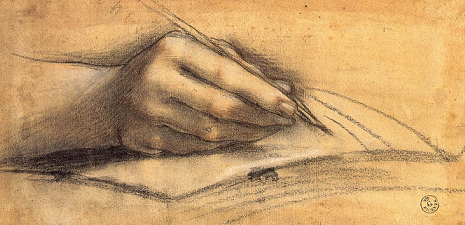
Old Master Drawings and Prints*
Academic Year 2025/20256 (starting in the 2nd semester)
This email address is being protected from spambots. You need JavaScript enabled to view it.
The class will start in the 2nd semester: Calendario Lezioni/Esami | Macroarea di Lettere e Filosofia
*Notice: This module is part of a highly specialized field of study and requires advanced knowledge of Early Modern Italian Art History.
Prerequisites
- knowledge of the art-historical context from the 14th to the 18th centuries;
- knowledge of the meaning of style, iconography, iconology and related topics in early modern art;
- to be sufficiently able to observe and describe a work of art (iconographic, technical and stylistic analysis), using the appropriate terminology.
Aims
At the end of this course, the student will be confident with the main theories, techniques and artists in the field of drawing in Italy from the 16th to the 18th centuries and he will have developed the related critical skills.
In particular
- knowledge of the artistic activity in Italy in the early modern age in the field of drawing;
- knowledge of both drawing and print techniques used in the early modern age as well as of the related ancient sources;
- skill in relating and comparing several works of art and artists, highlighting their differences as well as the elements of continuity and innovation;
- well-structured knowledge of the examined works of art, being able to recognize and contextualize them as well as to carry out an iconographic, technical and stylistic analysis.
- mastery of the discipline’s specific terminology;
- ability to critically organize and develop the topics and to bring them back to an overall context;
- to be able to explain the learned contents coherently and concisely.
Programme
The course, organised into centuries, schools and artistic tendencies, will be focused on topics that are essential to understanding the role of Drawing in the evolution of Italian and Western art, starting with the Early Renaissance up to the 18th century: prominent artists and their drawings; techniques and their developments; analysis of literary sources and documents.
- Overview: The first part is introductive and comprehensive, covering the history of drawing from the Middle Ages to Neoclassicism.
- Techniques: together with the analysis of drawing techniques, the leading exponents of Italian and European draughtsmanship and its main schools will be discussed and examined.
- Drawing typologies (i.e. Figure studies, Landscapes, Caricatures, Fakes, etc.) and features will be explained, as well as the concepts related to them, and the connected activities of drawing collecting and connoisseurship.
- Focus on some artists (depending on exhibitions, etc.), i.e. Leonardo da Vinci as a draughtsman. Particular attention will be given to the graphics production in Rome during the 16th century, mainly to Michelangelo and Raphael.
- The Art of Printmaking. Role of Prints and their Techniques: Woodcut, Engraving, Etching.
Visits to graphic collections (i.e. Istituto Centrale per la Grafica) and exhibitions are essential to the course.
Recommended Bibliography and Readings 2024/2025
Lecture notes and other material provided by the professor must be integrated with the following texts:
- “Fra Angelico to Leonardo. Italian Renaissance Drawings”, ed. by Hugo Chapman and Marzia Faietti, London, British Museum Press, 2010, especially pp. 10-85.
- Carlo James, “Visual Identification and Analysis of Old Master Drawings Techniques”, Florence, Leo S. Olschki, 2010.
- Hugo Chapman, “Michelangelo Drawings, closer to the Master”, London, British Museum Press, 2010 - or (at your choice)- "Raphael - The Drawings", ed. by C. Whistler and B. Thomas with A. Gnann and A. Aceto, Oxford, Ashmolean Museum, 2017.
---
Suggested reading:
- “Old Master Prints and Drawings, a guide to preservation and conservation”, ed. by C. James and M.B. Cohn, Amsterdam, Amsterdam University Press, 1997, pp. 1-86.
Other information
Alongside lectures, in the analysis of the works of art are planned classroom exercises, seminar activities and critical reading of ancient sources.
To allow students, through a direct examination of drawn and printed works, effective learning and an appreciation of the stylistic peculiarities of each artist and of the specificities of each technique, didactic visits will be agreed to graphic collections (Istituto Centrale per la Grafica, etc.) and to current exhibitions.
Assessment methods
The examination assesses the student's overall preparation, ability to integrate the knowledge of the different parts of the programme, consequentiality of reasoning, analytical ability and autonomy of judgement. In addition, the test assesses the student's ownership of language and clarity of expression, in accordance with the Dublin descriptors (1. knowledge and understanding; 2. applying knowledge and understanding; 3. making judgements; 4. learning skills; 5. communication skills).
The examination will be assessed according to the following criteria:
Not pass: important deficiencies and/or inaccuracies in the knowledge and understanding of the topics; limited capacity for analysis and synthesis, frequent generalizations and limited critical and judgmental capacity, the topics are set out inconsistently and with inappropriate language
18-20: knowledge and understanding of the topics just sufficient with possible generalisations and imperfections; sufficient capacity of analysis, synthesis and autonomy of judgement, the topics are frequently exposed in an inconsistent way and with inappropriate/technical language
21-23: routine knowledge and understanding of the topics; ability to analyse and synthesise correctly with sufficiently coherent logical argumentation and appropriate/technical language
24-26: fairly good knowledge and understanding of the subjects; good ability to analyse and synthesise, with arguments expressed in a rigorous manner but with language that is not always appropriate/technical
27-29: complete knowledge and understanding of the subject matter; considerable capacity for analysis and synthesis. Good autonomy of judgement. Arguments are presented in a rigorous manner and in appropriate/technical language.
30-30L: Very good knowledge and understanding of the topics. Excellent capacity for analysis, synthesis and independent judgement. Arguments are expressed in an original way and with appropriate technical language.
